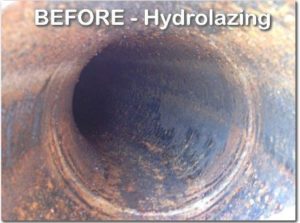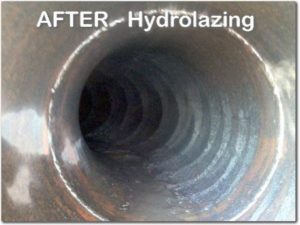Hydrolazing & Hydromilling Services
Hydrolazing, sometimes also referred to as aqualazing or hydromilling, is a high-pressure water jet cleaning method that can be used to remove mill-scale, construction debris, and process deposits from the internals of piping.
Hydrolazing is an effective service to use before steam blowing to remove mill scale from the steam piping. Performing hydrolazing prior to a steam blowing has many benefits including:
- Reduced cleaning times and costs of steam blowing by up to 75%
- Up to 80% less de-mineralized water required during the steam blow
- Significantly less fuel consumed to generate steam for the steam blow
- Minimal environmental impact because no chemicals are required
- Far less liquid waste generated than a similar chemical cleaning
Hydrolazing and hydromilling can be effectively used on combined cycle power plant equipment, refinery and petrochemical steam systems, process equipment experiencing a decline in performance from water contamination or process deposits, and process piping (for potentially lower costs than chemical cleaning). Learn more about our hydrolazing services below or contact RIG for a quote.
800-770-4510 (Domestic)
+1 281-339-5751 (International)


Step 1: During the cleaning a high-pressure water jet nozzle is sent down the piping via a hose. The nozzle is held against the pipe wall with one water jet while another smaller water jet blasts debris from the pipe wall.
Step 2: The hose is rotated and the nozzle circles around the pipe inner diameter while also progressing forward down the pipe. The result is a spiral motion of cleaning down the pipe.
Step 3: Debris removed from the pipe wall is washed backwards towards the hose inlet.
Air Products

Air Products Tees Valley Waste to Energy UK – The RIG team performed chemical cleaning of the HRSG’s, Hydrolazing of the Piping, Oil flushing of the CT’s / STG and steam blows of the headers and to the STG.
First Quantum Minerals

2 blocks Coal Fired Boilers- The RIG team performed chemical cleaning of the boilers, fuel oil piping and condensers. Hydrolazing on Steam, CCW, BFW and Condensate piping. Oil flushing of 2 SKODA STG’s. Impulse steam blows.
Woodville Power Plant

Woodville Power Project Woodville TX – RIG performed chemical cleaning on the boiler, hydrolazing of the boiler feed water, condensate and steam piping. Impulse steam blows.
Jaguar Power Plant

Jaguar Coal Fired Power Plant – 2 blocks Coal Fired Boilers- RIG performed chemical cleaning of the boilers. Hydrolazing on Steam, CCW, BFW and Condensate piping. Impulse steam blows.
Progress Energy

Hines Power Block Progress Energy Lakeland, FL – Chemical Plant Commissioning Project- New Combined Cycle project- Nooter Eriksen HRSG’s, Westinghouse CT’s and STG- Performed citric acid CC, Hydrolazing of all steam piping, air blows on Block 2 and continuous steam blows on Block 3.
Are Hydrolazing, Aqualazing, Aquablasting, Hydromilling and Hydroblasting the same thing?
Yes. They are all names that refer to a high-pressure water jetting method of debris removal from the internals of piping.
What is hydrolazing?
Hydrolazing is a high-pressure water jetting method effective at removing mill scale, construction debris, and process deposits. High pressure water removes debris without chemicals. Hydrolazing requires 80% less de-mineralized water than chemical cleaning and steam blowing and it typically shaves 5-8 days off a steam blowing procedure when performed first.
What is the water pressure used for hydrolazing?
15,000 psi to 20,000 psi is used to remove mill scale from the internal surfaces of pipe.
How big an inlet is required for the hydrolazing nozzle?
At least a 3” inlet is required to insert the hydrolazing nozzle through a drain. Specific piping configurations may require larger inlets.
How far and how many elbows can hydrolazing navigate on one run?
How far the nozzle will be able to travel down the piping is particular to the specific piping configuration. More elbows will limit total distance while a smaller pipe diameter will limit the number of bends the hose can handle. Speak to a RIG hydrolazing expert to have your individual system assessed.
When should hydrolazing be used?
This process is generally performed on steam piping prior to steam/air blowing of the steam lines to help reduce the time, water, and fuel required to clean the steam piping to an acceptable level required for a turbine manufacturer. Hydrolazing has also been utilized to clean closed cooling water lines, gas lines, and many other lines in the petrochemical, chemical and power industry in a fast and economical method to reduce the amount of waste water generated in the high velocity flushes of those lines. As an added benefit, the water used can be captured and recycled into the hydrolazing system.
What types of equipment is hydrolazing safe to be used on?
Hydrolazing is an effective pre-commissioning and plant reliability service that is appropriate for:
- New and revamped steam piping systems
- Combined cycle power plants (eg. 2×1 HRSG)
- Process equipment experiencing degraded performance from water contamination or process deposits
- Process pipes; often hydrolazing can clean systems at a lower cost than chemical cleaning methods.
Can the water be recycled?
Yes, the water can be captured from the piping and sent through settling tanks and filtration to allow for the reuse of this precious resource. This is particularly important in locations where water is scarce or liquid disposal is an issue.
Step 1: During the cleaning a high-pressure water jet nozzle is sent down the piping via a hose. The nozzle is held against the pipe wall with one water jet while another smaller water jet blasts debris from the pipe wall.
Step 2: The hose is rotated and the nozzle circles around the pipe inner diameter while also progressing forward down the pipe. The result is a spiral motion of cleaning down the pipe.
Step 3: Debris removed from the pipe wall is washed backwards towards the hose inlet.
Air Products

Air Products Tees Valley Waste to Energy UK – The RIG team performed chemical cleaning of the HRSG’s, Hydrolazing of the Piping, Oil flushing of the CT’s / STG and steam blows of the headers and to the STG.
First Quantum Minerals

2 blocks Coal Fired Boilers- The RIG team performed chemical cleaning of the boilers, fuel oil piping and condensers. Hydrolazing on Steam, CCW, BFW and Condensate piping. Oil flushing of 2 SKODA STG’s. Impulse steam blows.
Woodville Power Plant

Woodville Power Project Woodville TX – RIG performed chemical cleaning on the boiler, hydrolazing of the boiler feed water, condensate and steam piping. Impulse steam blows.
Jaguar Power Plant

Jaguar Coal Fired Power Plant – 2 blocks Coal Fired Boilers- RIG performed chemical cleaning of the boilers. Hydrolazing on Steam, CCW, BFW and Condensate piping. Impulse steam blows.
Progress Energy

Hines Power Block Progress Energy Lakeland, FL – Chemical Plant Commissioning Project- New Combined Cycle project- Nooter Eriksen HRSG’s, Westinghouse CT’s and STG- Performed citric acid CC, Hydrolazing of all steam piping, air blows on Block 2 and continuous steam blows on Block 3.
Are Hydrolazing, Aqualazing, Aquablasting, and Hydroblasting the same thing?
Yes. They are all names that refer to a high-pressure water jetting method of debris removal from the internals of piping.
What is hydrolazing?
Hydrolazing is a high-pressure water jetting method effective at removing mill scale, construction debris, and process deposits. High pressure water removes debris without chemicals. Hydrolazing requires 80% less de-mineralized water than chemical cleaning and steam blowing and it typically shaves 5-8 days off a steam blowing procedure when performed first.
What is the water pressure used for hydrolazing?
15,000 psi to 20,000 psi is used to remove mill scale from the internal surfaces of pipe.
How big an inlet is required for the hydrolazing nozzle?
At least a 3” inlet is required to insert the hydrolazing nozzle through a drain. Specific piping configurations may require larger inlets.
How far and how many elbows can hydrolazing navigate on one run?
How far the nozzle will be able to travel down the piping is particular to the specific piping configuration. More elbows will limit total distance while a smaller pipe diameter will limit the number of bends the hose can handle. Speak to a RIG hydrolazing expert to have your individual system assessed.
When should hydrolazing be used?
This process is generally performed on steam piping prior to steam/air blowing of the steam lines to help reduce the time, water, and fuel required to clean the steam piping to an acceptable level required for a turbine manufacturer. Hydrolazing has also been utilized to clean closed cooling water lines, gas lines, and many other lines in the petrochemical, chemical and power industry in a fast and economical method to reduce the amount of waste water generated in the high velocity flushes of those lines. As an added benefit, the water used can be captured and recycled into the hydrolazing system.
What types of equipment is hydrolazing safe to be used on?
Hydrolazing is an effective pre-commissioning and plant reliability service that is appropriate for:
- New and revamped steam piping systems
- Combined cycle power plants (eg. 2×1 HRSG)
- Process equipment experiencing degraded performance from water contamination or process deposits
- Process pipes; often hydrolazing can clean systems at a lower cost than chemical cleaning methods.
Can the water be recycled?
Yes, the water can be captured from the piping and sent through settling tanks and filtration to allow for the reuse of this precious resource. This is particularly important in locations where water is scarce or liquid disposal is an issue.

